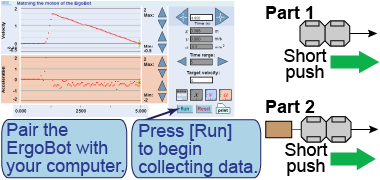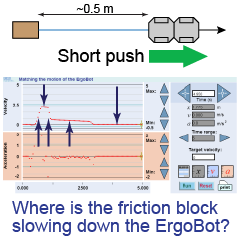|
| Essential questions | | How is friction included in models of motion? | |
|
The work done against friction reduces the amount of energy available for transformation into other forms. This is a significant way in which real systems are “open.” This investigation explores friction in a typical braking situation in which work done against friction reduces kinetic energy. 
|
Part 1: Rolling friction

- Set up the ErgoBot in freewheel mode on a level surface and give it a gentle push.
- Observe the position, velocity, and acceleration graphs on the computer as the ErgoBot is pushed and as it rolls freely to a stop.
- Write an equation expressing conservation of energy for the ErgoBot as it rolls to a stop.
- Solve the equation for the coefficient of rolling friction μr.
- Calculate μr using the data from your position and velocity graphs.

|
|
In this interactive element, you will capture real-time data from the motion of the ErgoBot and display the data as position versus time, velocity versus time, and/or acceleration versus time graphs.
|
Part 2: Kinetic friction
- Attach a friction block to one end of the ErgoBot with a short string and give it a gentle push.
- Observe the graphs for the motion of the ErgoBot and friction block until they come to rest.
- Draw separate free-body diagrams representing the ErgoBot and friction block while they slow down.
- Write a conservation of energy equation that includes the kinetic energy of the ErgoBot and friction block at the start and the work done against friction.
- Solve the equation for the coefficient of sliding friction μk.
- Calculate μk using the measured masses and data from your graphs.
- Create an equation model to predict the stopping distance.
- Add mass to the friction block and predict the stopping distance.
- Test your prediction with the ErgoBot, using the same initial velocity as before.
- Explain any differences between your prediction and measurement.

|
Part 3: Combining the two

- Reattach the friction block to the ErgoBot with about 1/2 m of string. Arrange the ErgoBot and block so that the ErgoBot can roll freely before putting tension on the string and moving the block.
- Observe the graphs on the computer as the ErgoBot is pushed, rolls freely, catches the friction block, and drags it until both come to rest.
- Identify where on the velocity–time graph (i) work is done on the ErgoBot and (ii) the ErgoBot does work on its environment (the friction block and surface).

|

